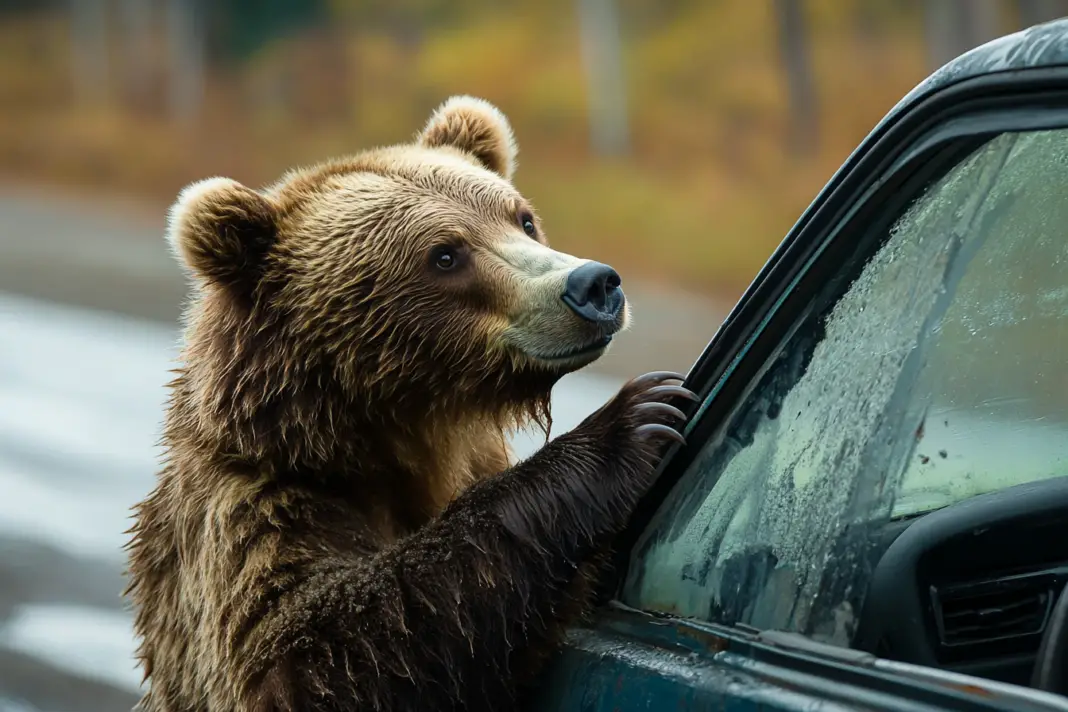Bears breaking into cars might sound like an urban legend, but it’s becoming an increasingly common reality in mountain communities across North America. From Colorado to British Columbia, these powerful creatures are turning unlocked vehicles into their personal playgrounds – with devastating results. The aftermath often leaves car owners facing thousands in repair costs and some very unpleasant surprises.
Why bears are attracted to parked cars
Bears possess an extraordinary sense of smell that’s approximately seven times stronger than a bloodhound’s. This remarkable ability means they can detect food odors from over a mile away, making parked cars particularly appealing targets. Even the smallest food remnants – a forgotten wrapper, spilled coffee, or crumbs under the seats – can attract these opportunistic foragers.
In Aspen, Colorado, local authorities have documented numerous cases where bears have targeted vehicles specifically because of food-related scents. The problem has become so prevalent that the city has implemented strict regulations requiring wildlife-resistant containers, with violations resulting in fines up to $1,000.
Bears are incredibly intelligent animals and have learned that vehicles often contain food. They’ve been observed testing car doors and windows systematically, much like a burglar would. This learned behavior has been passed down through generations of bears, making them increasingly adept at accessing vehicles when the opportunity presents itself.
The situation becomes particularly problematic during periods of natural food scarcity, when bears are desperately seeking alternative food sources. During these times, bears may spend hours investigating parked cars, especially in areas where they’ve previously found success in accessing food from vehicles.
The shocking extent of bear damage to vehicles
When a bear gains access to a vehicle, the destruction can be absolute and comprehensive. Recent incidents in British Columbia demonstrate the extensive damage these powerful animals can inflict. Bears have been known to completely destroy dashboards, tear out seats, and shred interior paneling in their search for food.
The damage isn’t limited to just the obvious torn upholstery and broken components. Bears often inadvertently trigger electronic systems, drain batteries, and damage wiring harnesses hidden beneath panels. Their powerful claws can puncture airbag systems and compromise other safety features, potentially rendering vehicles completely unusable.
Insurance adjusters report that bear damage claims often result in vehicles being declared total losses due to the extensive nature of the destruction. The combination of structural damage, compromised safety systems, and the biological contamination from the bear’s presence frequently exceeds the vehicle’s value.
Perhaps most disturbingly, bears have been known to leave additional unwanted surprises. Multiple reports from Aspen describe bears defecating in vehicles during their break-ins, adding another layer of cleanup complexity and potentially requiring specialized sanitation services.
Common entry points bears use to access vehicles
Bears have demonstrated remarkable ingenuity in accessing vehicles, with unlocked doors being their primary entry point. Surveillance footage from Gatlinburg, Tennessee shows bears systematically checking car doors and easily opening those left unlocked, displaying an almost human-like understanding of how door handles function.
Windows left partially open present another vulnerable access point. Bears can use their considerable strength to widen even small gaps, potentially breaking the window mechanism or bending the frame in the process. Some bears have been observed testing windows by pushing against them with their paws, looking for any weakness they can exploit.
Surprisingly, bears have also learned to identify and target specific vehicle types that might be more likely to contain food. SUVs and larger vehicles often attract more attention from bears, possibly because these vehicles are commonly used for camping and outdoor activities where food is typically transported.
In some cases, bears have even managed to break through seemingly secure entry points. There are documented instances of bears breaking through sunroofs or rear hatches, particularly in older vehicles where these components might be more vulnerable to forced entry.
Prevention strategies that actually work
The most effective prevention strategy is remarkably simple: always lock your vehicle. Colorado Parks and Wildlife officials emphasize this point repeatedly, noting that many bear incidents could have been prevented entirely if vehicles had been properly secured.
Remove all food items from your vehicle, including seemingly innocent items like gum, mints, or empty food containers that might retain appealing scents. Even non-food items with strong scents such as air fresheners, hand sanitizer, or lip balm can attract bears, so these should be removed or secured as well.
Regular cleaning of your vehicle’s interior can significantly reduce the risk of bear attraction. This includes vacuuming thoroughly to remove crumbs and food particles, and wiping down surfaces to eliminate food-related odors that might linger and attract wildlife.
For residents in bear-prone areas, consider installing motion-activated lights or alarms near parking areas. While these may not completely deter determined bears, they can alert homeowners to potential wildlife activity and provide an opportunity to safely scare the bear away before it causes damage.
The financial impact of bear damage
The financial consequences of bear damage to vehicles can be severe and far-reaching. Insurance claims for bear-related incidents often range from several thousand dollars to complete vehicle replacement, depending on the extent of the damage. Some insurance policies may not fully cover wildlife damage, leaving vehicle owners with significant out-of-pocket expenses.
Beyond the immediate repair costs, there are often hidden expenses associated with bear damage. These can include temporary transportation arrangements while the vehicle is being repaired, specialized cleaning services to address biological contamination, and potential long-term effects on the vehicle’s resale value.
The insurance industry has taken notice of this trend, leading to some interesting developments in coverage options. Some companies in bear-prone areas now offer specific wildlife damage riders or adjustments to comprehensive coverage to better protect vehicle owners from these unique risks.
The rising frequency of bear-related claims has even spawned a peculiar form of insurance fraud. Recent cases in California revealed individuals attempting to simulate bear damage using costumes and props, highlighting both the significant financial impact of legitimate bear damage and the lengths some will go to exploit insurance coverage.
Seasonal patterns in bear vehicle break ins
Bear activity involving vehicles follows distinct seasonal patterns that correlate with their natural feeding cycles. Late summer and early fall see a dramatic increase in vehicle break-in attempts as bears enter hyperphagia, a period of intense feeding to prepare for winter hibernation. During this time, bears need to consume up to 20,000 calories daily, making them particularly motivated to explore any potential food sources.
Spring emergence from hibernation marks another high-risk period. Bears, hungry after months without eating, become increasingly bold in their search for food. This timing often coincides with increased human activity in mountain areas as weather improves, creating more opportunities for bear-vehicle encounters.
Weather patterns can influence break-in frequency, with poor natural food years leading to more aggressive foraging behavior. During droughts or late frosts that affect berry crops, bears may be more likely to target vehicles as alternative food sources.
Tourist seasons in mountain communities also impact incident rates. Higher visitor numbers mean more improperly secured vehicles and food storage, leading to increased bear activity in parking areas. Many first-time visitors to bear country may be unaware of proper precautions, inadvertently creating opportunities for bear encounters.
What to do if you find a bear in your car
Discovering a bear in your vehicle requires careful handling of the situation to ensure both human and animal safety. The first and most crucial step is to maintain a safe distance – never approach the vehicle or attempt to confront the bear directly. Bears can quickly become aggressive if they feel cornered or threatened.
Contact local law enforcement or wildlife authorities immediately. These professionals have experience handling such situations and can safely remove the bear from the vehicle. In British Columbia, police officers have developed specific protocols for dealing with trapped bears, including breaking windows to provide escape routes.
While waiting for assistance, attempt to maintain visual contact with the vehicle from a safe distance. This helps ensure the bear hasn’t escaped and provides valuable information to responding authorities. If possible, warn others in the area to maintain a safe perimeter around the vehicle.
Document the incident with photos or video from a safe distance, as this may be helpful for insurance claims. However, never prioritize documentation over safety – bears can move surprisingly quickly and may exit the vehicle unexpectedly.
Understanding bear behavior near vehicles
Bears exhibit fascinating behavioral patterns when investigating vehicles. They often approach cars cautiously at first, circling to assess potential entry points and food sources. This investigative behavior demonstrates their intelligence and ability to learn from past experiences with human-created environments.
These animals show remarkable dexterity in manipulating car doors and windows. Video evidence from Gatlinburg shows bears systematically testing different entry points, suggesting they understand basic mechanical principles through learned behavior.
Once inside a vehicle, bears typically follow a predictable search pattern, first investigating areas where food is commonly stored – cup holders, center consoles, and back seats. Their thorough search often leads to extensive damage as they attempt to access every possible storage space.
Bears may remain in vehicles for extended periods, particularly if they find food sources or feel trapped. Their stress response in confined spaces can lead to more extensive damage as they attempt to create escape routes or respond to perceived threats.
The growing frequency of bear break-ins serves as a stark reminder of our responsibility in wildlife conservation. By taking simple precautions like locking vehicles and removing attractants, we not only protect our property but also contribute to the preservation of these remarkable animals. The solution to bear-vehicle conflicts lies not in more aggressive wildlife management, but in better human behavior and awareness. Through community education, proper preventive measures, and consistent application of bear-smart practices, we can significantly reduce these costly and potentially dangerous encounters while ensuring the long-term survival of bear populations in their natural habitats.

